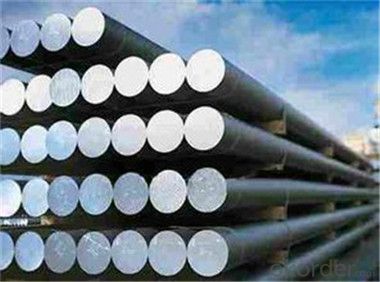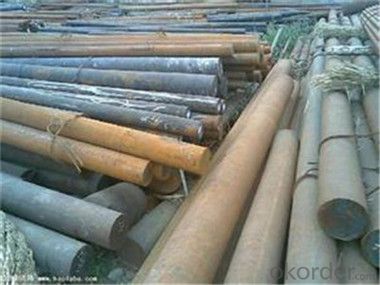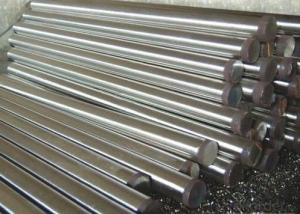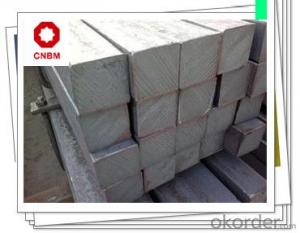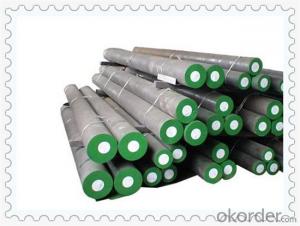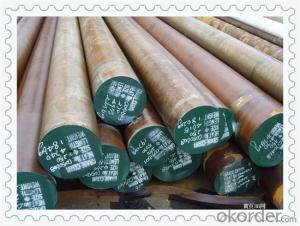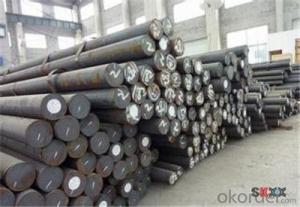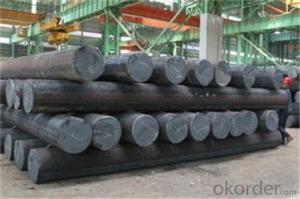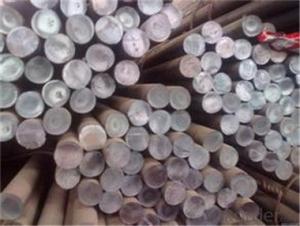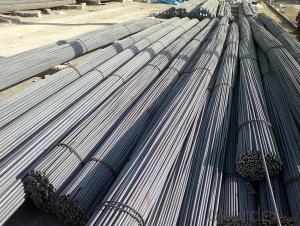Steel Round Bar Reliable manufacturer in China
- Loading Port:
- Tianjin
- Payment Terms:
- TT OR LC
- Min Order Qty:
- 400 m.t.
- Supply Capability:
- 2000000 m.t./month
OKorder Service Pledge
OKorder Financial Service
You Might Also Like
Description of steel round bar:
1. Commodity: Round steel bar
2. Technical: Hot rolling
3. Length: Min. 5.8meter, according to requirement.
Festures of steel round bar:
1.Dia 80-800mm Length:2000-13000mm or as required
2.Technique:Forged
3.Delivery Time:45 days
Specifications of steel round bar:
1. Standards: AISI 4340 8620 8640 4320 , JIS SNCM8 GB:40CrNiMoA
2. Specification: Dia: 80~450mm Length:2000-13000mm or as required
3. Process: EAF+LF+VD ( necessary) UT+ Peeled +Turned + Heat Treatment (optional).Providing complete services from manufacturing and marketing to distributing;Steel exported all over the world;
4. Chemical Composition (%):
C | Si | Mn | S | P | Cr | Ni | Cu | Mo |
0.37-0.44 | 0.17-0.37 | 0.40-0.80 | 0.025(max) | 0.025(max) | 0.60-0.90 | 1.25-1.65 | 0.025(max) | 0.15-0.25 |
Images of steel round bar:
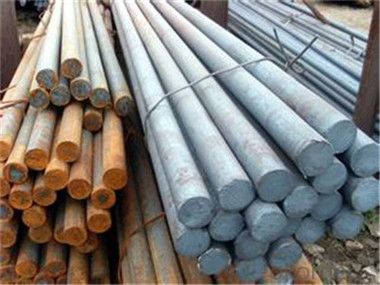
FAQ:
1. What is your package?
Packing situation: standard seaworthy packing or as customer required.
2. How long is the lead time?
Delivery time: 45 days after order confirmed.
3. What payment term do you accept?
Payment: T/T or L/C at sight.
- Q: What is the difference between a bright and a cold finished steel round bar?
- A bright steel round bar refers to a steel bar that has undergone a process called bright drawing, which involves passing the bar through a series of dies to achieve a smooth and shiny surface finish. On the other hand, a cold finished steel round bar is produced by cold drawing, which involves pulling the bar through a die to reduce its diameter and improve its dimensional accuracy. The cold finishing process does not result in a bright and shiny surface like bright drawing does, but it enhances the mechanical properties and overall quality of the bar.
- Q: Can steel round bars be used in the production of shafts?
- Yes, steel round bars can be used in the production of shafts. Steel round bars are often used as a raw material in the manufacturing process of shafts due to their strength, durability, and versatility. They can be machined or forged into the desired shape and size required for the shaft, and their inherent properties make them suitable for various applications such as automotive, machinery, and construction industries. Steel round bars offer excellent mechanical properties, including high tensile strength, good impact resistance, and resistance to corrosion, making them an ideal choice for shafts that require high load-bearing capacity and reliability. Additionally, steel round bars can be heat-treated to further enhance their strength and hardness, ensuring optimal performance and longevity of the shafts in various operating conditions.
- Q: How do you prevent warping of steel round bars during machining?
- There are several measures that can be taken to prevent warping of steel round bars during machining. These measures include: 1. Opting for the appropriate steel material with suitable mechanical properties is crucial. Choosing steel with lower carbon content and controlled alloying elements can help decrease the likelihood of warping during machining. 2. Before machining, it is important to conduct a stress relief process such as annealing or normalizing. This helps eliminate internal stresses in the steel round bars, thereby minimizing warping. 3. Utilizing proper machining techniques is essential in preventing warping. This involves using a stable and rigid machine setup, ensuring correct tool geometry and sharpness, and maintaining appropriate cutting speeds and feeds. Monitoring cutting forces and temperatures continuously can also assist in identifying any abnormal conditions that may contribute to warping. 4. Excessive heat generated during machining can cause localized expansion and lead to warping. To prevent this, it is recommended to use coolant or lubricant to dissipate heat and reduce friction between the tool and the workpiece. Sufficient cooling helps maintain a stable temperature and prevents warping. 5. When machining long steel round bars, it is advisable to use appropriate fixtures or supports to prevent excessive deflection or bending. This ensures that the bar remains straight and stable during machining, reducing the chances of warping. 6. Even after machining, stress can still be present in the steel round bars. Performing a post-machining stress relief process, such as tempering or normalization, can further alleviate any residual stresses and minimize the risk of warping. By implementing these measures, the risk of warping during the machining of steel round bars can be significantly reduced. This leads to improved dimensional accuracy and overall quality of the machined parts.
- Q: Can steel round bars be used for making furniture?
- Yes, steel round bars can be used for making furniture. Steel round bars are strong, durable, and have a sleek and modern appearance. They can be used to create various types of furniture, such as tables, chairs, stools, and shelving units. Steel round bars can be welded, bent, and shaped to create unique and custom designs. Additionally, they can be paired with other materials such as wood or glass to create a combination of textures and styles. Steel round bars also have the advantage of being resistant to corrosion, making them suitable for both indoor and outdoor furniture. Overall, steel round bars offer versatility and strength, making them an excellent choice for furniture-making projects.
- Q: Can steel round bars be used for making springs or suspension components?
- Yes, steel round bars can be used for making springs or suspension components. Steel is a commonly used material for these applications due to its high strength, durability, and ability to handle heavy loads. The round shape of the bars allows for easy fabrication into various spring designs or suspension components. Additionally, steel can be heat-treated to improve its elasticity and resistance to fatigue, which are important characteristics for springs and suspension systems. Overall, steel round bars provide a reliable option for manufacturing springs and suspension components that can withstand the demands of these applications.
- Q: Can steel round bars be used in the manufacturing of machinery?
- Yes, steel round bars can definitely be used in the manufacturing of machinery. Steel round bars are widely used in various industries for their strength, durability, and versatility. They are commonly used to create components such as shafts, axles, gears, and other mechanical parts that require high strength and resistance to wear and tear. Steel round bars offer excellent mechanical properties, including high tensile strength and good machinability, which make them suitable for use in heavy machinery and equipment. Additionally, steel round bars can be easily welded, forged, or machined into the desired shape, making them a preferred choice for manufacturing machinery.
- Q: Can steel round bars be used for making suspension springs?
- Yes, steel round bars can be used for making suspension springs. Steel is a common material choice for suspension springs due to its strength, durability, and ability to withstand high loads and vibrations. Steel round bars can be readily shaped, tempered, and heat-treated to meet the specific requirements of suspension springs, providing necessary flexibility and resilience.
- Q: Can steel round bars be used in marine environments?
- Yes, steel round bars can be used in marine environments. However, it is important to choose the right type of steel that is specifically designed for marine applications. Stainless steel is the most commonly used type of steel in marine environments due to its corrosion-resistant properties. It contains a high percentage of chromium, which forms a protective oxide layer on the surface of the steel, preventing corrosion from saltwater and other harsh elements. Additionally, stainless steel round bars are known for their strength and durability, making them suitable for various marine applications such as shipbuilding, offshore structures, and marine equipment. Regular maintenance and proper care are also essential to ensure the longevity and performance of steel round bars in marine environments.
- Q: What is the difference between hot rolled and cold rolled steel round bars?
- The production methods and resulting qualities of hot rolled and cold rolled steel round bars differ. Hot rolled steel round bars are created by heating billets or ingots to a high temperature and shaping them into the desired form using rolling mills. This process yields a scaled surface and a relatively rough texture. The dimensions of hot rolled steel round bars have a wider tolerance and are less precise. They are commonly used in applications where precision is not crucial, such as construction and general manufacturing. In contrast, cold rolled steel round bars are produced by cooling down hot rolled steel to room temperature and subjecting it to further processing through cold rolling mills. This process leads to a smoother surface and more accurate dimensions. Cold rolled steel round bars have a tighter tolerance and are frequently employed in applications that require precision, like automotive components, machinery parts, and tools. Regarding mechanical properties, hot rolled steel round bars generally possess lower tensile strength and yield strength compared to cold rolled steel round bars. Cold rolled steel also tends to have higher hardness and a more uniform grain structure, which can enhance its strength and durability. In summary, the primary distinction between hot rolled and cold rolled steel round bars lies in their production process, surface finish, dimensional accuracy, and mechanical properties. The selection between the two depends on the specific requirements of the application and the desired qualities of the final product.
- Q: What is the difference between carbon steel and stainless steel round bars?
- The composition and properties of carbon steel and stainless steel round bars differ significantly. Carbon steel round bars are composed primarily of iron and carbon, with trace amounts of other elements. They are renowned for their strength and durability, making them ideal for use in industries like construction and automotive. In terms of affordability, carbon steel round bars are generally more cost-effective than stainless steel round bars. In contrast, stainless steel round bars are a type of steel alloy that contains a minimum of 10.5% chromium. This addition of chromium gives stainless steel its distinct properties, including resistance to corrosion. As a result, stainless steel round bars are highly resistant to rust and staining, making them suitable for use in environments exposed to moisture and chemicals. Industries such as food processing, medical equipment, and marine applications commonly utilize stainless steel round bars. The chromium content in stainless steel round bars generally leads to higher prices compared to carbon steel round bars. However, the added cost is justified by the superior corrosion resistance and aesthetic appeal of stainless steel. Furthermore, stainless steel offers a range of grades and finishes, allowing for customization based on specific requirements. In conclusion, the primary distinction between carbon steel and stainless steel round bars lies in their composition and properties. Carbon steel is known for its strength and affordability, while stainless steel provides corrosion resistance and various customization options. The choice between the two depends on the specific application and the desired properties required for the project.
Send your message to us
Steel Round Bar Reliable manufacturer in China
- Loading Port:
- Tianjin
- Payment Terms:
- TT OR LC
- Min Order Qty:
- 400 m.t.
- Supply Capability:
- 2000000 m.t./month
OKorder Service Pledge
OKorder Financial Service
Similar products
Hot products
Hot Searches
Related keywords




